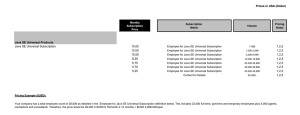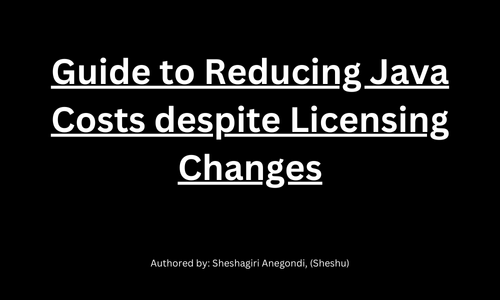Reducing Java costs has become important in the view of license changes made by Oracle two years ago in January 2023.
There are a large number of articles in this website about Java licensing across publishers (Oracle Java, OpenJDK & Non-Oracle Java). This specific article gives you an overview of the changes and how to reduce costs.
Contents of the article are
- Key Changes to Java Licensing
- Interpretation of the Employee Metric
- Cost of Oracle Java
- Cost of Non-Oracle Java
- How to Reduce Costs
- Can you pay zero for Oracle Java?
Introduction
This article will give you details of Java license changes, Oracle Java Costs, alternative models and how to reduce costs. Oracle’s 2023 shift to employee-based pricing for Java SE via the Universal Subscription has significantly altered the licensing landscape. Businesses must understand the implications of this change to avoid unnecessary costs.
What are the Java License Changes?
Key Changes to Java licensing
- 2018-19:
- End of Public Updates
- OTN Agreement for Java
- New updates and versions would be on OTN Agreement
- OTN Agreement says Java SE has to be procured with payment of subscription fees for commercial use.
- 2021
- NFTC Agreement
- NFTC is ‘No Fee Terms & Conditions’
- Oracle said that all LTS releases Java SE17 and onwards would be under the NFTC agreement.
- The NFTC agreement would be applicable for a period three years and updates for one more year after that
- NFTC Agreement
- 2023:
- New ‘Employee’ license metric announced for Java SE subscriptions.
- Old metrics were discarded for new purchases.
What is the Employee Metric for Java?
• Oracle announced in January 2023 the new metric for Java SE subscriptions.
• This license metric is called “Universal Employee for Java SE Subscription”
• The old metrics, i.e. Processor and Named User Plus are no longer available for Java SE subscriptions for purchase by end-user companies.
Definition and Interpretation of the Java SE Employee Metric
Definition:
Employee for Java SE Universal Subscription:
is defined as (i) all of Your full-time, part-time, temporary employees, and (ii) all of the full-time employees, part-time employees and temporary employees of Your agents, ontractors, outsourcers, and consultants that support Your internal business operations. The quantity of the licenses required is determined by the number of Employees and not just the actual number of employees that use the Programs. For these Java SE Universal Subscription licenses, the licensed quantity purchased must, at a minimum, be equal to the number of Employees as of the effective date of Your order. Under this Employee metric for Java SE Universal Subscription Programs(s), You may only install and/or run the Java SE Universal Subscription Program(s) on up to 50,000 Processors, If Your use exceeds 50,000 Processors, exclusive of Processors installed and/or running on desktop and laptop computers, You must obtain an additional license from Oracle.
Interpretation of the Java SE Employee Metric
Customers must pay for
- All Employees. Employees include:
- Full-time, part-time employees
- Temporary Staff
- Contractors, Consultants, Agents & Outsourced personnel
- Important Notes:
- Java installation on even one machine requires all the employees to be licensed.
- There is no correlation between the actual usage and the amount of subscription fees to be padi
How much does Oracle Java Cost?
The extract from the price list is below:

Pricing Examples
| Employee Size | Annual Java SE Subscription Fees | Per Employee Annual Cost |
|---|---|---|
| 1000 | $144000 | $144 |
| 3000 | $378,000 | $126 |
| 5000 | $630,000 | $126 |
| 7500 | $945,000 | $126 |
| 10000 | $990,000 | $99 |
| 15000 | $1,485,000 | $99 |
| 20000 | $1,620,000 | $81 |
| 25000 | $2,025,000 | $81 |
| 30000 | $2,052,000 | $68 |
| 35000 | $2,394,000 | $68 |
| 40000 | $2,52,0000 | $63 |
| 49999 | $3,149,000 | $63 |
| >50,000 | Contact Oracle Sales | NA |


